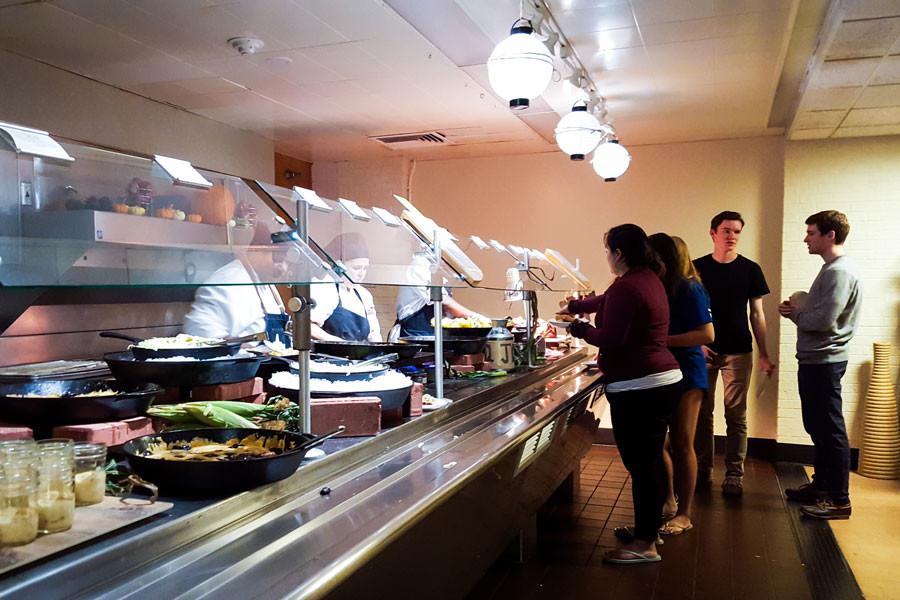Points for a Purpose teams with NU Dining to find ways around $2,000 cap
Daily file photo by Sophie Mann
Students stand in line at the Foster-Walker East dining hall. Northwestern’s Points for a Purpose program faces a $2,000 cap and will work to collect additional leftover Wildcat Points from students.
October 29, 2015
Facing a $2,000 cap, Northwestern’s Points for a Purpose program will push to collect additional leftover Wildcat Points from students.
Points for a Purpose first launched in 2013 for students to donate unused Wildcat Points from their meal plan to provide food to members of the Evanston community in need. The $2,000 cap, in place from the beginning, refers to the University-issued limit on the number of unused points that can be donated to Points for a Purpose, said Rachel Tilghman, director of communications and engagement for Sodexo.
At the end of Fall Quarter 2014, Points for a Purpose raised $5,500 through its points drive because NU Dining did not activate the cap due to a change in leadership and misunderstanding, said McCormick junior and Points for a Purpose co-chair Daniel Sosnovsky. Because the cap was not in place, Points for a Purpose received all the money but was told in Winter Quarter that the cap had been reactivated, Sosnovsky said.
Tilghman said because the money comes from students’ meal plan fees, the University has an expectation of how many of these points will be allocated to Points for a Purpose based on a preset budget.
“The program requires the university to make a donation — basically, they’re matching whatever the students say they’re going to donate, as it’s actually coming from the university’s points that you’ve paid them for,” Tilghman said. “There is a limit of $2,000 per quarter just because of operating costs and the translation of what food costs would be.”
Right now, Points for a Purpose is working with NU Dining to find ways to expand the program around the $2,000 cap, Sosnovsky said. The two groups have met several times per quarter, discussing solutions to expanding both the points drive and NU Dining’s programs.
“Our relationship with NU Dining is overwhelmingly positive,” Sosnovsky said. “We have very casual and friendly conversations with NU Dining, so we do like to maintain constant communication with them, especially during the points drive when they will give us updates on how we’re doing.”
Tilghman worked with the two students who co-founded Points for a Purpose from the beginning in 2013 to help them get the word out about the new program and communicate with the operations directors of NU Dining. Now, Tilghman said she serves as an adviser to the two co-chairs of Points for a Purpose: Sosnovsky and Communication sophomore Matt Faden.
“The Evanston community benefits greatly from Points for a Purpose because the community itself does have a high need for food, especially for the holiday season and summer months when school is out,” Tilghman said. “Students also find it meaningful to turn what would have been theirs into an item for the greater good.”
The money collected through Wildcat Points is placed into a budget through which Points for a Purpose can allocate funding for different programs. They place food orders through NU Dining, which buys the food at cost for the amount that was donated. Funds are distributed to campus programs and the greater Evanston community, Faden said.
Campus Kitchens, one of the programs that receives donations from Points for a Purpose, benefits greatly from the charity, putting 100 percent of donations toward operations to feed those in need in the Evanston community, said Samantha Warren, coordinator of NU Campus Kitchens.
“A lot of the things we buy, we wouldn’t be able to source from anywhere else, so Points for a Purpose is really helpful for us to be able to make meals that are not only filling, but also healthy and well-balanced, which is sometimes hard to do with recovered food,” Warren said.
Though the cap on the points drive is already activated for this quarter, Faden and Sosnovsky look forward to implementing new solutions in upcoming quarters.
“(NU Dining) has been helping us look at grants and other ways of raising even more money,” Faden said. “Together, we’re looking at every opportunity, including expanding the cap and ways around the cap, so that we can have as great of an impact as we possibly can.”
Email: [email protected]
Twitter: @fathma_rahman


